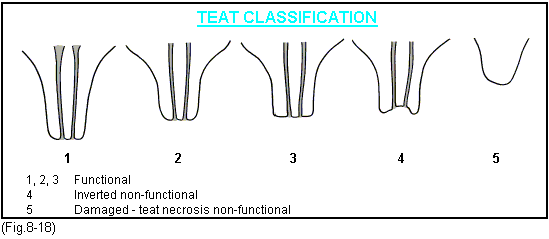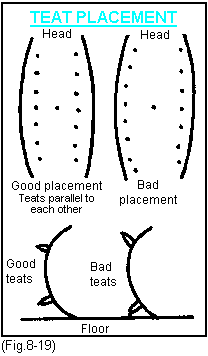



The udder
A healthy functional well-formed udder is vital to piglet survival not only to provide colostrum and milk but also to give all the piglets easy teat access.
Teat and udder conformation
There are two fundamental factors that decide whether a sow can rear 12 or more pigs; first whether all piglets are able to get access to teats and second whether they can suck milk freely from them. These may seem obvious but how seriously are they considered when the gilt is being selected? It is not uncommon to see a gilt at farrowing with no functional teats at all, or a sow farrowing with say, five viable teats and the remainder non functional. But selection for good teats and udders is not as easy as it sounds, particularly if the number of females to choose from is small. Some teats that appear small and inverted at selection may develop and be fully functional at parturition and vice versa. Fortunately, in large herds the odd mistake can usually be mitigated by cross-fostering. Nevertheless, if you are a farmer who selects gilts from your own herd you should not forget that successful rearing of litters starts at gilt selection.
Teat conformation
A basic understanding of the anatomy of the teat is helpful if good functional ones are to be selected and their conformation can be classified from 1 to 5 (Fig.8-18). The perfect teat is elongated and pointed with two teat canals opening to the exterior. A class 2 teat will not be so elongated but the teat end protrudes well down. Class 3 is the cut-off point for selection and this is where the teat sphincter (often appearing as a black dot) can still be seen when viewed at eye level. A class 4 teat is one where the teat sphincter is not visible, in other words the teat canal is shortened resulting in an inverted teat. Such a teat should be considered non viable. A proportion of inverted teats will be drawn out by the piglet at suckling, but at least 50% of them will remain blind. Why take the risk? A class 5 teat is usually one where the teat has been rubbed off in the first 48 hours of birth. (Teat necrosis).

Teat numbers
The optimum or minimum number of functional teats on the breeding gilt is a debatable point.
The ideal would be 16 teats, but this may represent only 5% of the gilt population, with around only 25% having 14 - so the commercial choice is 12 good teats with 14 or 16 in the Meishan cross breed. If however, you are selecting gilts from your own herd, select 14 or more if possible.
Teat placement
The position of the teats on the udder is equally as important as teat conformation. It is no use having 14 perfect teats if their placement results in poor accessibility at birth. Teats should be equally spaced with no supernumerary ones and be in two parallel lines. When teats diverge they are poorly presented to the piglet at birth. Animals with large girths also exaggerate the teat placement. (Fig.8-19).

Bad teat conformation is one of the major reasons why a breeding female will not rear 11 or 12 pigs. There may be a history in a herd of good litters born yet by the time the pigs are five days of age, two or three begin to show signs of lack of milk they loose condition and have to be fostered. Two pigs can survive on one teat in the first 12-24 hours after farrowing but eventually the stronger pig takes over and the other is left with the teat that has now become accessible but it has started to dry off.
The placement of good teats on the boar that is used to produce breeding females should also be given due emphasis at selection.
Reputable breeding companies selling replacement breeding stock are fully aware of the importance of teat conformation, teat numbers and teat placement and make their examination an important part of the selection process. However, demand for gilts may be variable and selection rates (e.g. 50%, 60%, or 70%) have a bearing on profitability. As a commercial producer buying gilts you should always check their underlines on arrival.
Teat necrosis
It has been recognised for a number of years that within 18 hours of birth some of the teat sphincters on those teats in front of the umbilical cord are traumatised by the floor surfaces. This causes the sphincter to become necrotic (die). It is most likely to occur in piglets born with swollen, oedematous teats and glands which results from the sow's female hormones crossing the placenta. Such damage occurs on most floor surfaces but is obviously worse on rough floors and is almost complete within 24 hours of birth. If gilts are to be selected, their teats should be protected from this trauma as soon as possible after birth. In some circumstances this can be helped by maintaining a deep bed of straw or shavings beneath the sow but in many cases this is not practical. The alternative is to protect the teats by painting them with cow gum, (which is a rubber solution, often used for attaching photographs to paper), contact adhesive or covering them with adhesive zinc oxide elastoplast for up to 36 hours.
Selection technique
Gilts for breeding can be selected initially at five days of age (and ear notched) for conformation and 12 to 14 good pointed well placed teats. This will give an indication of the number of animals that are potentially available for selection at a determined future date and with a simple computer programme details of availability at that date can be predetermined. Up to 90% (but allow for no more than 75%) of these animals should be finally selected at 90kg weight.
Potential breeding animals should be examined first in a confined space such as a weigh crate to check the teats. If a five day selection has been carried out you will know that most gilts will have 12 to 14 teats. The ideal is to set a weigh crate on a ramp so that the gilts udder is 0.9-1.2m from the ground. The observer can then carry out a detailed examination and at the same time assess the lateral displacement of teats. The final selection should be based upon a normal vulva, overall conformation and ease of movement to reduce the risk of leg weakness.
Recognising impending disorders and possible lactation failure
These must be determined at the onset and the following procedures will help:
- The udder of every sow at farrowing and 12 to 24 hours afterwards should be palpated. The palm of the hand is placed over each gland with the teat in the centre and pressure applied to a normal gland to the point at which the sow just responds. This standard is then used to detect any abnormal pain and changes in texture to the other glands.
- The presence of oedema or fluid in the vulva or in the surface tissues between the legs should be noted.
- A finger should be pressed hard into a gland to see whether a small impression is left behind. If so this is further evidence of the very early stages of oedema.
- The first detectable changes are usually seen 4 to 6 hours after farrowing but occasionally severe mastitis or infection of the gland would be evident before farrowing in which case inappetence and failure to suckle are observed.
- The experienced stockman or the veterinarian will recognise lactation failure by behavioural changes in the sow, lack of alertness and failure to lie over and suckle.
- Affected glands may be discoloured and swollen.
- The sow may be off her food with a fever and laid on her belly.
The first indication of lactation failure is shown in the piglets by raised hair, hollow flanks and they actively seek food.
Disorders associated with the udder can be grouped into four conditions;
- Udder oedema and failure of milk let down.
- Mammary hypoplasia.
- Agalactia.
- Mastitis





